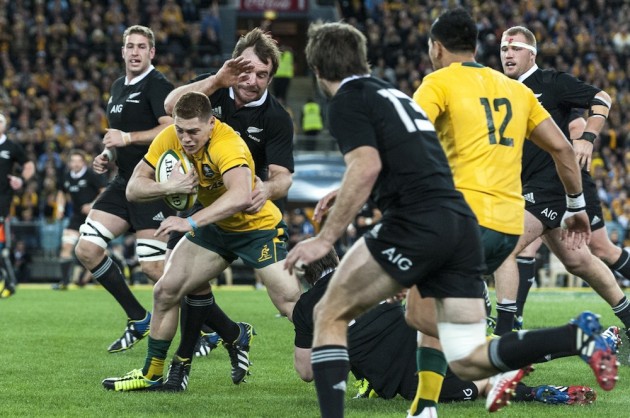As both a Wallaby supporter and rugby coach, that was a tough match to watch. However, while there were deficiencies, there are also some clear opportunities for improvement, and there were also a few areas where the Wallabies bettered the AB’s. Here are a few quick thoughts from me.
The Wallaby wings
The All Blacks had a strategy of which wing they wanted to play down. Despite some positional lapses from the league/AFL convert, it was clear they intended to keep the ball away from Israel Folau and instead target James O’Connor.
Defensively Folau was only forced into making three tackles in the match with a 100% success rate. O’Connor attempted 6 with a 50% success rate, two of those failures were part of All Black tries in the first 30 minutes.
The New Zealand kicking game favoured either Mogg or O’Connor as targets and steered well away from Folau. However, between the Wallaby back line and some positional uncertainty from Folau, the Wallabies’ key attacking weapon made only four runs for 35 metres, whereas O’Connor made 11 for 110 metres. Folau could learn something here; O’Connor went looking for work, Folau needs to do the same.
Getting Folau into the match will be a tactic the Wallabies will look to work on and something Izzy should take responsibility for.
The lack of Wallaby go forward
One of the characteristics of the match was the inability of the Wallaby pack’s back five (locks and back row) to generate sustained go forward. Rob Simmons and James Horwill did a lot of carrying in the match with 13 and 12 runs respectively (only Richie McCaw bettered them with 14 runs), but any sense of continuity around the tackle contest was hard to find for the Wallabies.
There are a couple of things here. Most teams look to generate go forward in or around the ruck 1st in order to disorganise, condense and or over-commit the defence. Once they achieve this teams look to get the ball to space and speed as quickly as possible.
To prevent this the AB’s
- Play a condensed, somewhat offside ruck defence making it very difficult to find a space to run into – consequently you have bodies running into bodies, and
- They are very good at slowing down the ruck and will quite happily give up a penalty if it means preventing fast ball off the back of any go forward. Their tendency to be offside also means that, even if your halfback is playing off the deck, the defence is across the advantage line when they meet the ball carrier. Genia doesn’t play too much off the deck, so the one step he takes, or even just standing up to pass gives the defence time to take another half-metre. There are ways around this; some tactical but also selection based, and it does offer up opportunities elsewhere which is what the Wallabies will be looking at this week.
The battle between Michael Hooper and Richie McCaw was a fascinating one. Hooper’s work rate is outstanding and McCaw after six months away from the game seems to have not missed a beat. We’ve got some highlights in the video below.
The mobility of the Wallaby front row
It may not be a fashionable message, but the mobility of the Wallaby front row is a real point of difference compared to their Kiwi counterparts and I’m sure using this skill set better is something the Wallabies attack coach will have in the back of his mind.
The front row made 20 runs to seven, and were first at rucks 22 times to seven (although this also says something about the Wallaby back row). Tackle-wise they were pipped 36-25, but that’s in line with amount of possession the Wallabies held.
The Lineout
When the Wallaby team was named I think many would have thought that the Wallabies might look to play for the lines; Matt Toomua, Christian Leali’ifano and Jesse Mogg are all good kickers and the Brumbies game plan revolves around field position, so the skill set and experience seemed to match that tactic. Naming Hugh McMeniman and Ben Mowen in the back row gives you an excellent defensive lineout and if the AB’s have a achilles heal, it’s probably the throwing consistency of Andrew Hore and Keven Mealamu.
The Wallaby lineout did outplay their counterparts, taking all of their own attacking throws (9 from 9), and pounced on some All Black errors including Simmons twice picking off cleanly by getting up in front of Kieran Read. In all, the Wallabies pressured mistakes on six of the 13 New Zealand line outs (46%). You can see them in the video below.
I think a bit more of a focus on this tactic early on may have put the AB’s under more pressure and provided a few more opportunities for the Wallabies down their end of the pitch. The All Blacks looked to keep the ball away from the touchlines with only five of their 23 tactical kicks going to touch. For the Wallabies it was seven out of their 16, giving one of best counter attacking units in world rugby nine easy possessions to have some fun with.
I’d like to see the Wallabies exploit this more in the following Tests, as well as sending some restarts long – none of the seven Wallaby restarts went long and the AB’s seemed well prepared to contest anything short. Forcing lineouts in the All Black half of the field or fielding kicks around halfway could well pay dividends, at least as an interim tactic as the Wallaby go forward and attack structures develop.



